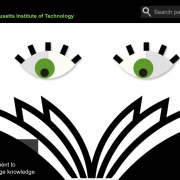Study tracks eye movement to determine how well people understand English as a foreign language.
Peter Dizikes | MIT News Office
May 22, 2018
Excerpt:
A study by MIT researchers has uncovered a new way of telling how well people are learning English: tracking their eyes.
That’s right. Using data generated by cameras trained on readers’ eyes, the research team has found that patterns of eye movement — particularly how long people’s eyes rest on certain words — correlate strongly with performance on standardized tests of English as a second language.
“To a large extent [eye movement] captures linguistic proficiency, as we can measure it against benchmarks of standardized tests,” says Yevgeni Berzak, a postdoc in MIT’s Department of Brain and Cognitive Sciences (BCS) and co-author of a new paper outlining the research. He adds: “The signal of eye movement during reading is very rich and very informative.”
Indeed, the researchers even suggest the new method has potential use as a testing tool. “It has real potential applications,” says Roger Levy, an associate professor in BCS and another of the study’s co-authors.
The paper, “Assessing Language Proficiency from Eye Movements in Reading,” is being published in the Proceedings of the 16th Annual Conference of the North American Chapter of the Association for Computational Linguistics: Human Language Technologies. The authors are Berzak, a postdoc in the Computational Psycholinguistics Group in BCS; Boris Katz, a principal research scientist and head of the InfoLab Group at MIT's Computer Science and Artificial Intelligence Laboratory (CSAIL); and Levy, who also directs the Computational Psycholinguistics Lab in BCS
—-
Follow link below to read full article.
Scientific paperr refernced in article is "Assessing Language Proficiency from Eye Movements in Reading," by Yevgeni Berzak, Boris Katz, Roger Levy, 16th Annual Conference of the North American Chapter of the Association for Computational Linguistics: Human Language Technologies, In Press.
URL: https://cbmm.mit.edu/publications/assessing-language-proficiency-eye-movements-reading

